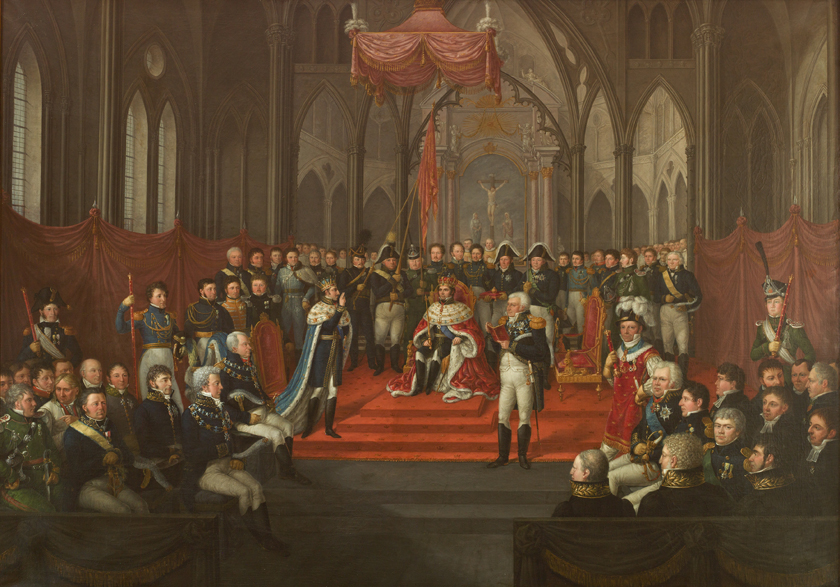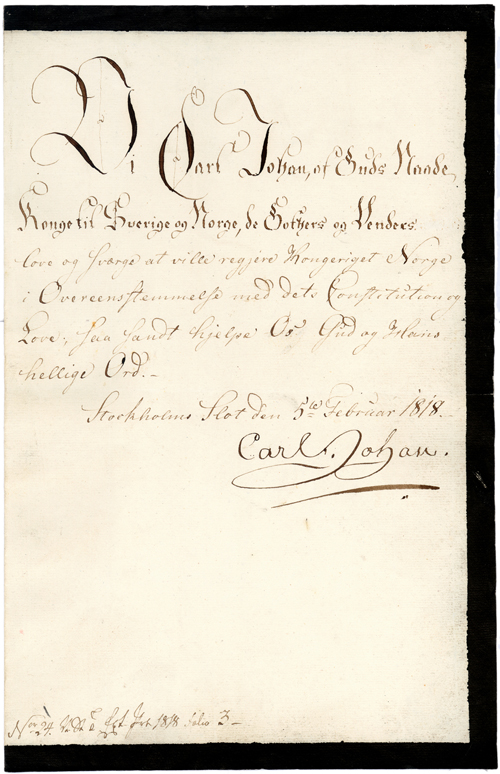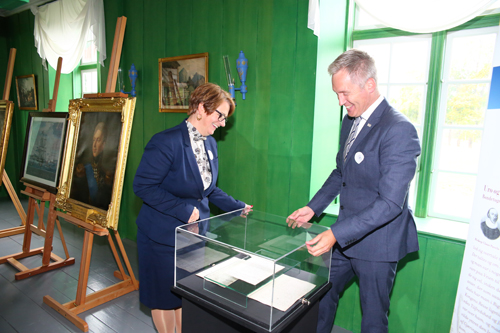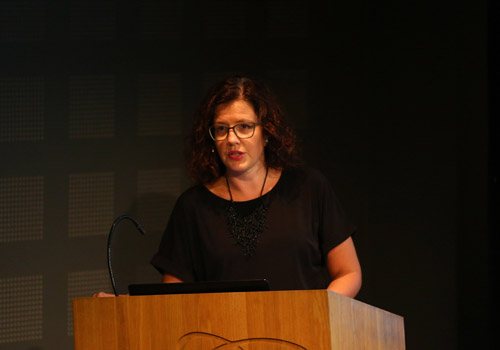
King Carl Johan’s coronation in Nidaros Cathedral on 7 September 1818, painted by Jacob Munch in 1822. Photo: Jan Haug, Royal Collections.
King Carl Johan 1818–2018
Two hundred years have passed since Carl Johan (1763–1844) became King of Norway. The President of the Storting opened an exhibition at Eidsvoll Manor House to mark the anniversary.
King Carl Johan was crowned on 7 September 1818 in Nidaros Cathedral in Trondheim. The President of the Storting opened an exhibition at Eidsvoll Manor House to mark the anniversary, and in the Storting itself you can view the oath sworn by Carl Johan pursuant to the Norwegian Constitution.
Crown Prince Carl Johan
In 1810, Carl Johan was elected Sweden’s crown prince, but he was born French and had been one of Napoleon’s marshals. The union between Norway and Sweden was a result of his policies in the years prior to 1814, and it was Carl Johan who was the architect of the Treaty of Kiel, under which Norway was transferred by the Danish king to the Swedish king.
From 1814 until the death of Carl XIII, Crown Prince Carl Johan was the de facto regent of the Norwegian-Swedish union, as the King was unable to fulfil his duties due to age and illness.

Carl Johan’s oath, sworn on 5 February 1818. The black margin around the document indicates official court mourning in the wake of Carl XIII’s death. The oath was formulated in accordance with Section 9 of the Norwegian Constitution of 4 November 1814. Storting Archives.
Carl Johan’s oath
On 5 February 1818, the date of Carl XIII’s death, Carl Johan was sworn in as the new king in accordance with the Constitution:
Section 9. As soon as the King, being of age, accedes to the Government, he shall swear to the Storting the following oath: “I promise and swear that I will rule the Kingdom of Norway in accordance with its Constitution and Laws; so help me God and his Holy Word!”
On 11 February, the oath was presented to the Storting (Norway’s parliament) by the Governor-General and the Government.
In his greetings to the new king, on behalf of the Storting, District Governor Sibbern said:
... the people of Norway view trustingly the sceptre of the United Kingdoms in the King’s powerful hand, which to Europe’s admiration unites the boundless affection and esteem of the Kingdoms. [...] that the people of Norway never betrayed — and never will betray — their rightful King.
Crowning journey to Trondheim
Carl Johan was crowned King of Sweden on 11 May at Storkyrkan, or Stockholm Cathedral. The Storting sent a deputation of 12 representatives to attend the event. In response, the Swedish Riksdag, or parliament, decided that a deputation of its own should be sent to the coronation in Norway.
The Constitution established that the King was to be crowned in Nidaros Cathedral in Trondheim. In August 1818, therefore, Carl Johan arrived in Norway en route to Trondheim. At the time, the Storting was busy with its work and the King did not wish to disturb its members with a coronation journey to Trondheim, as he wrote to the Storting in a statement. It was agreed instead that the Storting should appoint another 12-person deputation to take part in the coronation itself. This deputation was headed by District Governor Wilhelm F. K. Christie and consisted, in addition to himself, of four farmers, three officers, three district court judges and a merchant.
Carl Johan’s coronation journey went from Christiania (as Oslo was then named) to Eidsvoll Verk, then north through the Østerdalen and Gudbrandsdalen valleys before arriving in Trondheim on 1 September. During the following week several balls and other festivities were held. The Storting’s deputation arrived in Trondheim on 3 September. In an audience with the King and the Crown Prince, the representatives extended official greetings from the Storting before concluding: “We have nothing further to add, except our humble assurance of the devotion and loyalty of all the people.”
On 7 September, the Storting’s deputation took part in a solemn procession with Carl Johan to Nidaros Cathedral for his coronation as King of Norway. The Crown Prince, later called Oscar I, took an oath of allegiance to the Constitution at the same time. The coronation of Carl Johan in 1818 was the first royal coronation in Norway for 300 years.

Storting President Tone Wilhelmsen Trøen and Eidsvoll 1814 Director Bård Frydenlund examine documents lent by the Storting Archives for the exhibition. Photo: Eidsvoll 1814.
Celebrating the coronation’s bicentenary
Carl Johan visited Eidsvoll Verk on several occasions apart from his coronation journey. On 6 September 2018, the museum Eidsvoll 1814 celebrated the bicentenary of his coronation with an all-day seminar on Carl Johan. The seminar featured British, French, Swedish and Norwegian researchers shedding light on different aspects of Carl Johan’s formidable career and what it was like to establish a new dynasty in the Nordic region.
During the seminar, Storting President Tone Wilhelmsen Trøen opened the exhibition Kronen på Verket about Carl Johan, Eidsvoll and Norway. The exhibition will continue in Eidsvoll Manor House (where the Norwegian Constitution was signed in 1814) until 31 October 2018. It conveys the complex undertakings of a royal figure who opposed, accepted, protected and repeatedly sought to change the Norway’s Constitution.

Historian Marthe Hommerstad of the Storting Archives addresses the Eidsvoll seminar on Carl Johan and the Storting, whose relationship throughout Carl Johan’s reign was marked by power struggles. Photo: Eidsvoll 1814.
Oath on view in the Storting
The Storting is marking the 200th anniversary with an exhibition in the Eidsvoll Gallery of Carl Johan’s oath of allegiance to the Constitution. The oath, part of the Storting Archives, can be viewed when the Storting opens its doors to the public on Culture Night, 14 September.
See also
For more information about Carl Johan and his coronation in Norway in 1818, please see the website of the Royal House of Norway.
Last updated: 10.09.2018 09:27